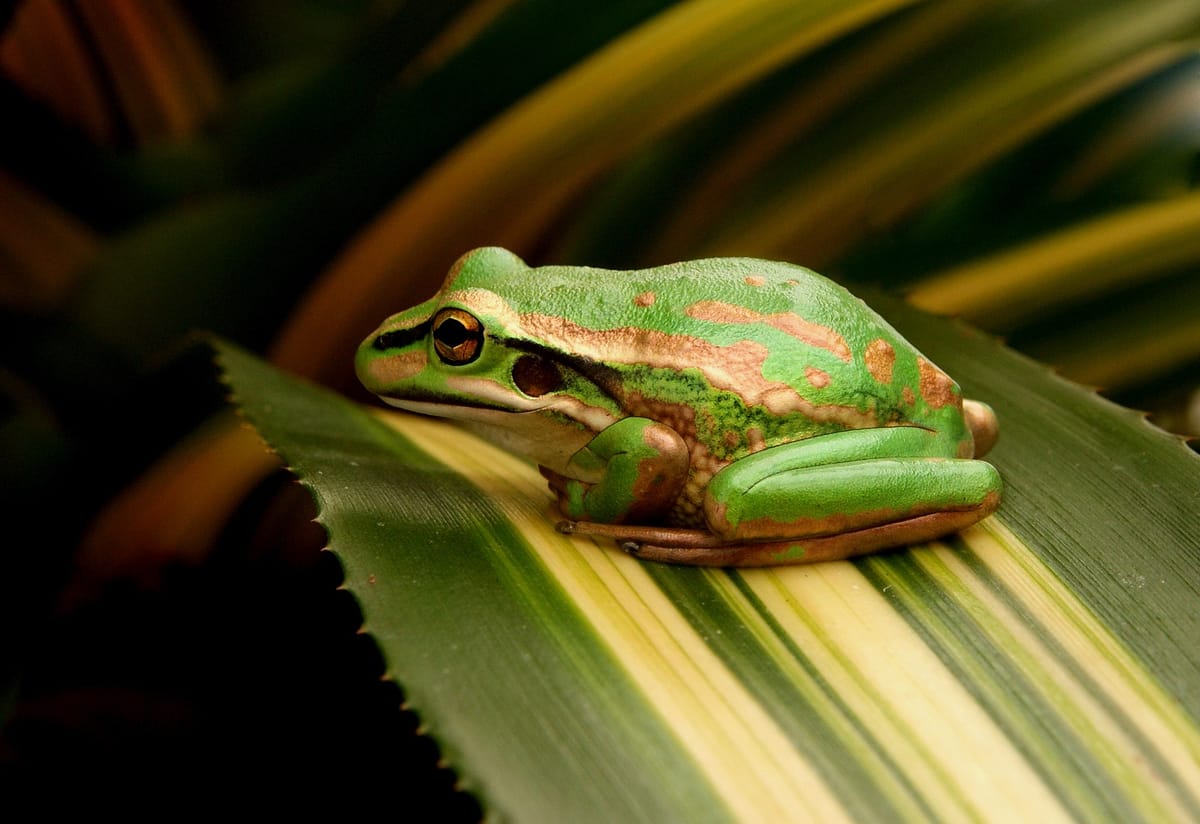The Frog Pond #21: Saunas Save Frogs
Frogs are in danger around the world from a fungus infection. One research team's found an innovative solution for an Australian frog species using miniature saunas.

Hello fellow frogs, old and new! This month's topic is a good news story, if you're a frog fan.
Frog saunas
Researchers in Australia have found a unique treatment for the Australian green and golden bell frog infected with a deadly Batrachochytrium dendrobatidis fungus (also known as Bd)1.
Using isolating greenhouse structures and black-painted mason bricks with 10 small, round holes, researchers were able to create mini saunas for the infected frogs. Due to the greenhouse effect, the warmer temperature help the frogs survive. After their stay at the luxurious (for a frog) spa, these frogs were found 22 times more likely to resist repeat infection!1
This frog species was once common in south-eastern Australia and are now much rarer, but scientists are hopeful that this treatment (which hadn't been effective with other frogs) will help their population bounce back1.

Fungus vs. frogs
This Bd fungus has been the culprit of many amphibian extinctions. It's responsible for at least 90 species extinctions around the world1 and for at least 500 species declining2. This fungal infection is the "greatest recorded loss of biodiversity attributable to a single disease"1.
Bd causes chytridiomycosis in amphibians, which attacks their skin and causes heart attacks. Researchers believe the deadliest strain, which appeared about 100 years ago, was likely spread by the human frog trade1,2.
Some species have survived in captivity, where they can recover in isolation, such as the Tanzanian Kihansi spray toad and Mexican claw-toothed salamander1. But reintroduction is difficult when these species are still susceptible.
The success of the green and golden bell frog might be a species-specific fluke, but it also represents a breakthrough that has the potential to be duplicated in the future1.
How do the saunas work?
The researchers, led by Dr Anthony Waddle at Macquarie University in Sydney, created a greenhouse effect using hollowed bricks, greenhouse tents, and heated ponds hot enough to kill the fungus but not the frogs1.
Similar to the human flu season, the outbreaks of chytridiomycosis tend to occur in winter. The saunas are set up during the winter months to keep the frogs warm and "bake off" the infections2.
A crucial part of this experiment was up to the frogs themselves to want to stay in the warmth. Luckily the green and golden bell frogs flocked to the saunas during field experiments, quickly fighting off the infection2.
The research group are building more shelters at Sydney Olympic Park, which houses one of the largest remaining populations of green and golden bell frogs2.
Become a citizen scientist!
Dr Waddle had a few tips if you'd like to help save the frogs:
- Download the FrogID app to learn how your local frogs are doing. Record their calls to help scientists identify them, adding valuable data for froggy conservation.
- Build your own frog sauna to help keep your backyard frogs healthy through the winter. The team has provided a handy PDF guide on how to build it with local hardware store parts.
(These are particular to Australians, but similar conservation programs for frogs, birds, and many other animals are happening all over the world that need citizen scientists as well!)
A word from a passing frog
It's a quiet slide into August after a chaotic July. I got to go to Switzerland! I visited close family I haven't been able to in ages, enjoyed the alps first-hand, and even saw Taylor Swift!
This month I want to get a lot of writing done, enjoy the back-half of summer with lots of swimming, and set myself up for a balanced Fall.
Writing
I've written the first 7k of the new book! I joined in #AllYouCanWriteAugust over on Twitter and Instagram and talked a bit about the project there.
This book has a different vibe while drafting than THE DROWNED COAST (which, if you missed last month's announcement, is going to be published by Sourcebooks in 2025!).
While TDC was about complex sisterhood and toxic sacrifice and fighting for the scrap of good in yourself, this one is both more focused and broader at the same time. I'm sitting on over 50 characters in my Notion database (!!) compared to the less than 10 in TDC, but this book has one protagonist instead of two. Following Willow's journey into the dangerous, autumnal world of Hemlock College feels intimate. Though maybe first drafts always feel this way and a few years of distance from TDC's first draft journey have dulled the memories!
Whatever the case, I think the two books will complement each other well. TDC is fish spines, hibiscus tea, and a flooding dancefloor of family trauma and capitalist exploitation through dark magic. This new project is for anyone that's felt the bone-ache of not measuring up to your own expectations, or those of mentors you thought you could trust.
Reading
I can sum up this month's reading in one word: Dune.
I read Dune Messiah (#2), Children of Dune (#3), and I'm currently 65% of the way through God Emperor of Dune (#4). That's roughly 1,300 pages of Dune. I'm happy to report that the quality of the audiobook production hasn't swayed from the phenomenal first book! I've enjoyed a lot of aspects while reading this massive, ambitious series, though there are more and more uncomfortable moments of unquestioned sexism and racism (to name a few) as the series goes on that can really weigh you down.
I'm taking a break from the series after #4 to read some newer books, including a borrowed copy of Ordinary Monsters by J.M. Miro.





